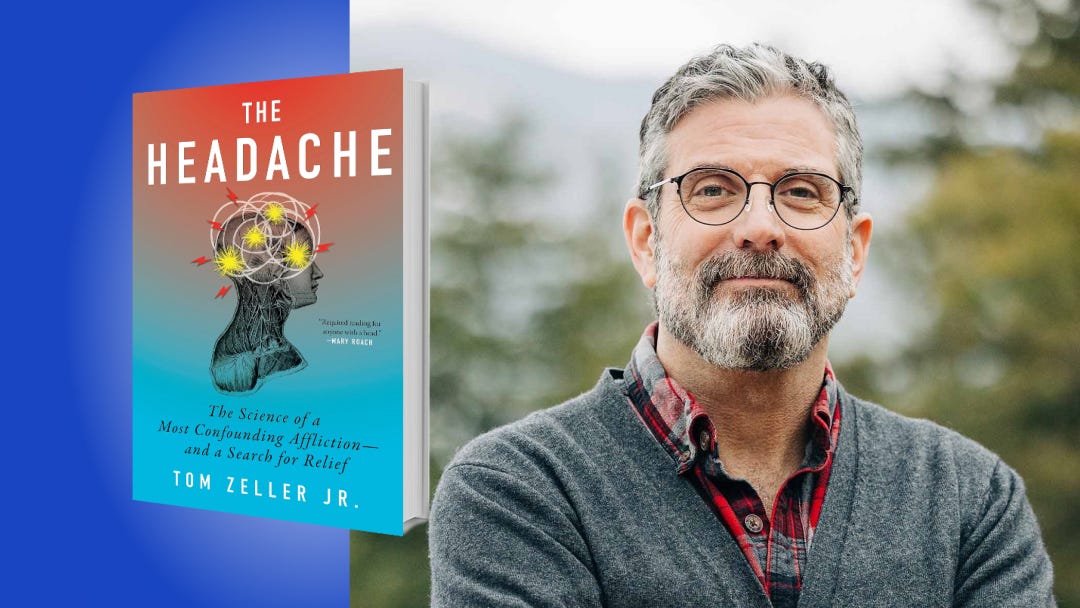What Your Headache Is Trying to Tell You
Millions suffer in silence from a misunderstood brain disorder. Science is finally starting to listen.
Listen now on Spotify or Apple Podcasts:
It starts as a throb. Or a stab. Or a strange pressure behind one eye.
Whatever the sensation, for millions of people around the world, it signals the beginning of something awful: a migraine, a cluster headache, or another form of chronic, grinding head pain. These aren’t symptoms of another illness—they are the illness. And despite being among the most common neurological disorders on Earth, they remain profoundly misunderstood, underfunded, and often trivialized.
Science journalist Tom Zeller Jr. knows this all too well—both as a longtime sufferer and as the author of The Headache: The Science of a Most Confounding Affliction—and a Search for Relief. In his new book, he uncovers the murky science, medical neglect, and cultural baggage surrounding headache disorders—and explains why, at long last, researchers are beginning to pay serious attention.
Pick up a copy of the book on Amazon or read Tom’s key insights below:
1. Headache disorders are not a modern phenomenon.
Although it makes sense to reason that our era of endless distraction might be the driving force behind migraine and cluster headaches, they didn’t emerge with smartphones, processed food, or fluorescent lighting (though those things certainly didn’t help).
Headaches resembling what we now call migraine appear in ancient Egyptian papyri, in Hippocratic texts, and later in ancient writings of Roman physicians and Persian medical scholars. In many cases, these weren’t just considered physical ailments; they were framed as spiritual afflictions or divine punishments. But the salient aspect of a uniquely one-sided pain in the head seems to have been clearly described for millennia. The term migraine itself evolved from the ancient Greek word hemicrania, which literally means half the skull.
In this light, modern migraine sufferers (along with those burdened by other primary headache disorders) join a long lineage of sufferers—and scientists—struggling to make sense of this invisible, grinding head pain.
2. Headache disorders remain remarkably mysterious.
For something so common, headache disorders have historically been a black box for science. Migraines alone affect more than a billion people worldwide, yet our understanding of their underlying physiology remains surprisingly incomplete. This is partly because the central nervous system, where these conditions arise, is so profoundly complex. But it’s also because the headache, as a research domain, has never been especially fashionable.
“Migraines alone affect more than a billion people worldwide, yet our understanding of their underlying physiology remains surprisingly incomplete.”
The field is inarguably underfunded and understudied, considering both the personal burden on individual sufferers and the economic burden arising from lost productivity. And yet, as a potential area for scientific or clinical specialization, the headache has often been seen as occupying a soft corner of neurology rather than hard neuroscience. That dismissal is reflected in public health priorities, funding decisions, and medical training. The result has been a decades-long delay in really grappling with these disorders at a truly empirical and molecular level.
This week, Book of the Day is brought to you by Lead Boldly, a transformative read that marries the timeless wisdom of Dr. Martin Luther King, Jr. with practical leadership strategies. This remarkable guide offers a deep dive into the principles that defined Dr. King’s impactful leadership and provides actionable insights to incorporate his visionary ideals into your own leadership journey. Get your copy today.
3. Unlucky branding (and pervasive misogyny) have played a role.
Gender plays a central role in why headache science stalled out. Migraines disproportionately affect women, with hormonal fluctuations clearly implicated in the timing and severity of attacks. For much of the 20th century, that biological reality was reframed as psychological fragility.
Some clinicians theorized that migraine was a manifestation of female neurosis, or repressed desire, or dissatisfaction with domestic life. The diagnosis itself carried baggage: not just pain, but implication. Add to that the word “headache” itself, which does double duty in the culture as a synonym for “minor annoyance,” and you’ve got a recipe for trivialization. Even today, migraine remains culturally diminished—too common to seem serious, too gendered to be neutral, and too metaphorically overloaded to be legible as disease.
That linguistic baggage matters. When a condition is framed as ordinary, even banal, it becomes harder to fund, harder to teach, and harder to take seriously. Headache disorders didn’t just inherit a complex biology; they inherited a marketing problem.
4. Things are finally getting a bit more sophisticated.
Real scientific traction began in the 1990s with the advent of sumatriptan, the first of the triptan drugs designed to abort migraine attacks by acting on serotonin receptors. It wasn’t a cure, but it was a revelation for many patients, offering rapid relief and a glimpse of what targeted treatment might look like. In 2018, another breakthrough arrived: anti-CGRP medications.
“When a condition is framed as ordinary, even banal, it becomes harder to fund, harder to teach, and harder to take seriously.”
CGRP, short for calcitonin gene-related peptide, is a neuropeptide that spikes during migraine attacks and seems to play a central role in pain signaling. Drugs that block CGRP, or its receptors, can significantly reduce the frequency and severity of attacks in many sufferers. But the key word there is “many.” It does not work for everyone, and real-world efficacy studies suggest that while some patients are so-called “super responders,” who receive near-total relief, for others, the effects are mild or even non-existent.
That’s not to suggest that the CGRP medications aren’t revolutionary—they really are—and they have opened investigations into still other neurotransmitters that might make even better targets. But even among those who do respond, we’re now learning that the effect can wane over time. The drugs offer some hope, but they don’t cure migraine or cluster headache. While they represent a leap forward in headache science, they also highlight the deeper truth: we still don’t fully understand the underlying architecture of these very common disorders.
5. The crime scene is still active.
CGRP was a huge clue, but it wasn’t the full story. Scientists are racing to identify other molecules, pathways, and mechanisms that might hold the key to more consistent and complete treatments. But they’re not exactly unified in their approach.
Researchers disagree on fundamental questions: Where, exactly, is the pain of a migraine attack located? Is it arising somewhere in the pain-sensitive tissues surrounding the brain? Is it a function of blood vessels? And where are these new drugs performing their work? Are they getting inside the brain, or are they exerting their salient effects somewhere in the peripheral nervous system? The answers to such questions remain murky, and some of today’s most prominent scientists differ bitterly over competing explanations.
The headache brain resists simple narratives. We have some sketches of the culprit, but the crime scene remains messy, the motives are unclear, and the evidence refuses to paint a clear picture. In that sense, the science of headaches remains an active and somewhat sluggish investigation. The key perpetrator is still very much at large.
Tomorrow: Member Book Chat
Our next Members-Only Book Chat will be on Thursday, August 7th at 11am ET. We will be discussing Eric Topol’s bookSuper Agers: An Evidence-Based Approach to Longevity.
If you’re not already a paid subscriber, join us below to see the RSVP link and claim your spot!






